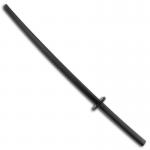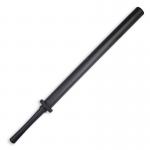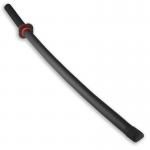Foam Practice Swords & Padded Swords for Sparring
-
$34.95
-
$39.95
-
$34.95
What makes these different from cheap toy swords is the way they are constructed. Many of them feature a plastic or fiberglass inner core that gives the blade structure, while the outer layer is made of dense foam to reduce the impact during training. This provides just enough firmness to feel realistic without being overly rigid. Some are better suited for martial arts training, while others are ideal for costumes, roleplay, or choreographed movement.
Some of the foam katanas in this section also work well as accessories for ninja costumes or Halloween outfits. They have the right look and length to pair with a martial arts uniform or ninja gi, and they offer a much safer option than a hard plastic or metal costume weapon. While they are still training tools first, a lot of people pick them up for cosplay, theater, or dress-up events because of their lightweight construction and padded design.
Foam swords are also a great way to introduce kids to martial arts concepts without the intimidation factor of heavier weapons. They are light, easy to grip, and durable enough to hold up to repeated practice. If you are looking for a padded alternative that still feels like a real sword in motion, this is a great place to start.
Are Foam Swords Used in Martial Arts?
Foam practice swords are commonly used in martial arts schools that emphasize light-contact sparring or movement drills. They're especially helpful in styles that involve sword techniques but don't always use full-contact weapons. Whether you're working through flow drills, experimenting with timing, or introducing weapons to a new student, foam swords offer a forgiving way to practice without sacrificing the feel of a real blade.
They're also popular for stage combat and live demonstrations, where safety and visual appeal both matter. The padded exterior reduces the chance of injury during quick movements or choreographed strikes, while the structure underneath gives the weapon a realistic shape and presence. For martial artists doing demos at schools, tournaments, or public events, foam swords strike a great balance between safety and performance.
Outside the dojo, foam swords are often used in costume events, cosplay, or role-playing games. They're lightweight, easy to carry, and don't raise the same safety concerns as harder prop weapons. If you're dressing up as a ninja, samurai, or fantasy warrior, a foam katana adds the right visual impact without the risk.
Durability and Design Features
While these swords are designed for safety, they're still built to last. Most have a solid internal core made of PVC or fiberglass to keep the blade from bending or snapping during use. The foam layer varies in density but is thick enough to handle light sparring and repetitive drills. Some include grip wrapping for a better hold, while others feature plastic or rubberized hand guards to protect your fingers.
It's important to remember that foam swords are not indestructible. If they're used too aggressively or for heavy-contact sparring, they can wear out or split over time. That said, when used for light-contact practice or costume use, they hold up surprisingly well. They're also a smart option for instructors who want a safer alternative when teaching new or younger students.
Are Foam Swords Safe for Sparring?
Foam swords are generally safe for light-contact sparring, especially in controlled environments like martial arts classes or demonstrations. Most are padded with high-density foam and have a flexible inner core, which helps absorb impact and reduce the chance of injury. That said, they should still be used with caution. Protective gear, supervision, and proper technique are all important, especially when kids are involved. These swords aren't meant for full-contact or hard strikes, but they work well for drills, timing practice, and soft sparring.
What Is the Difference Between a Foam Sword and a Toy Sword?
While they might look similar at first glance, foam practice swords are designed for real training and controlled sparring, not just play. A toy sword is usually made from thin plastic and isn't built to withstand repeated impact. Foam swords, on the other hand, typically have a solid internal core made from PVC or fiberglass, plus a layer of durable foam for padding. They feel more like real weapons in terms of size and grip, which makes them much better suited for martial arts practice, stage combat, or costume use where structure and durability matter.
What Styles of Martial Arts Use Foam Swords?
Foam swords are most commonly used in martial arts styles that focus on safe sparring and weapons practice. They're especially popular in Kendo and Kenjutsu for light-contact drills, though practitioners often use shinai or wooden bokken in those disciplines as well. Foam swords are also used in Taekwondo or Karate programs that incorporate weapons training for kids or beginners, where safety is a top concern. They're not specific to any one style, but they're a practical tool for schools that want to introduce sword techniques without the risk of injury from harder materials.
How Heavy Are Foam Swords Compared to Real Ones?
Foam swords are significantly lighter than real swords made of wood or metal. Most are designed for speed, safety, and ease of use, which means they weigh just a fraction of what a traditional bokken, katana, or steel blade might weigh. This makes them easier to handle for kids, beginners, or anyone working on footwork, flow, or technique without the strain of a heavier weapon. While they don't offer the same weight distribution or feedback as a live blade, they're ideal for building confidence and coordination before moving on to more advanced training tools.













 (1)
(1)



















